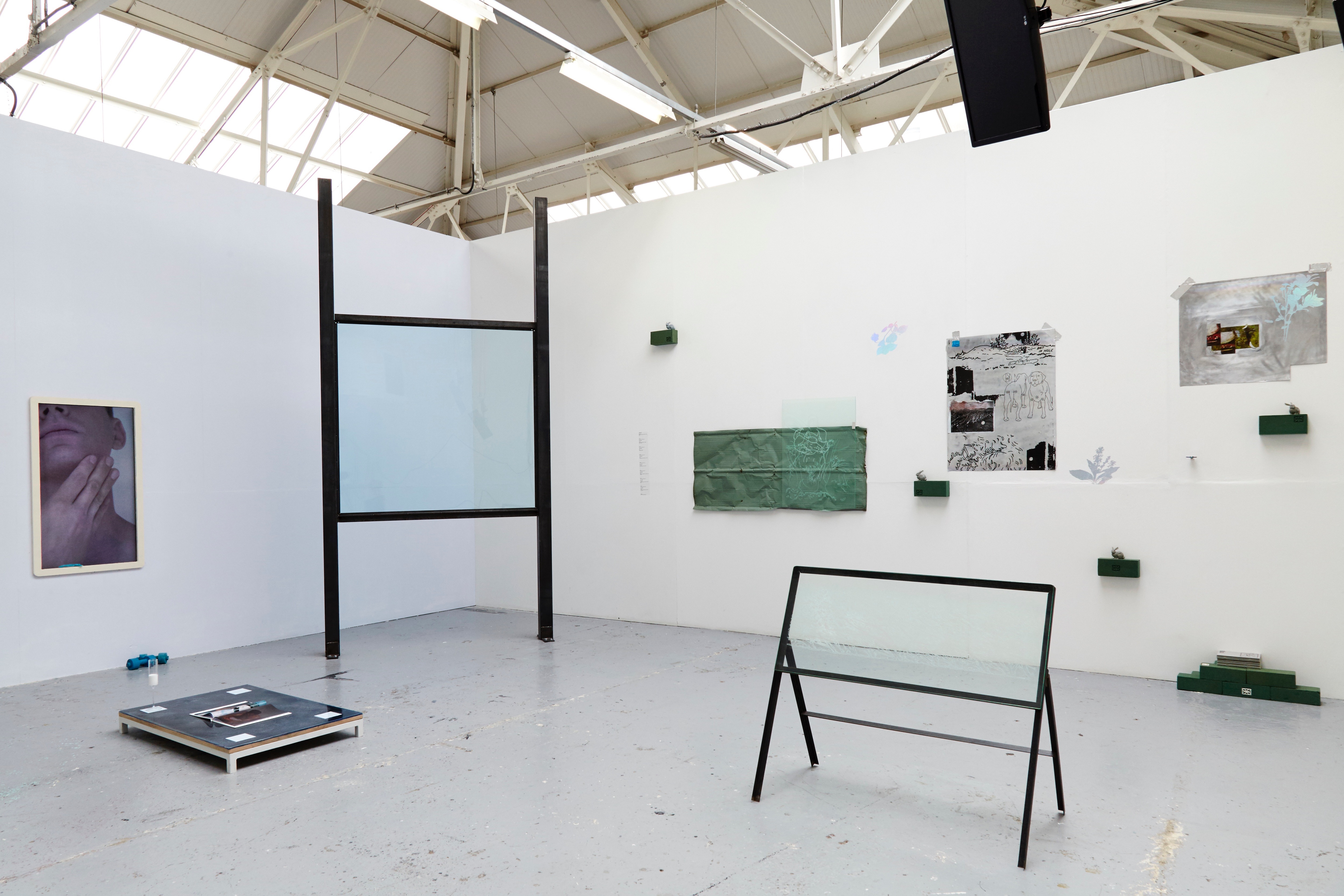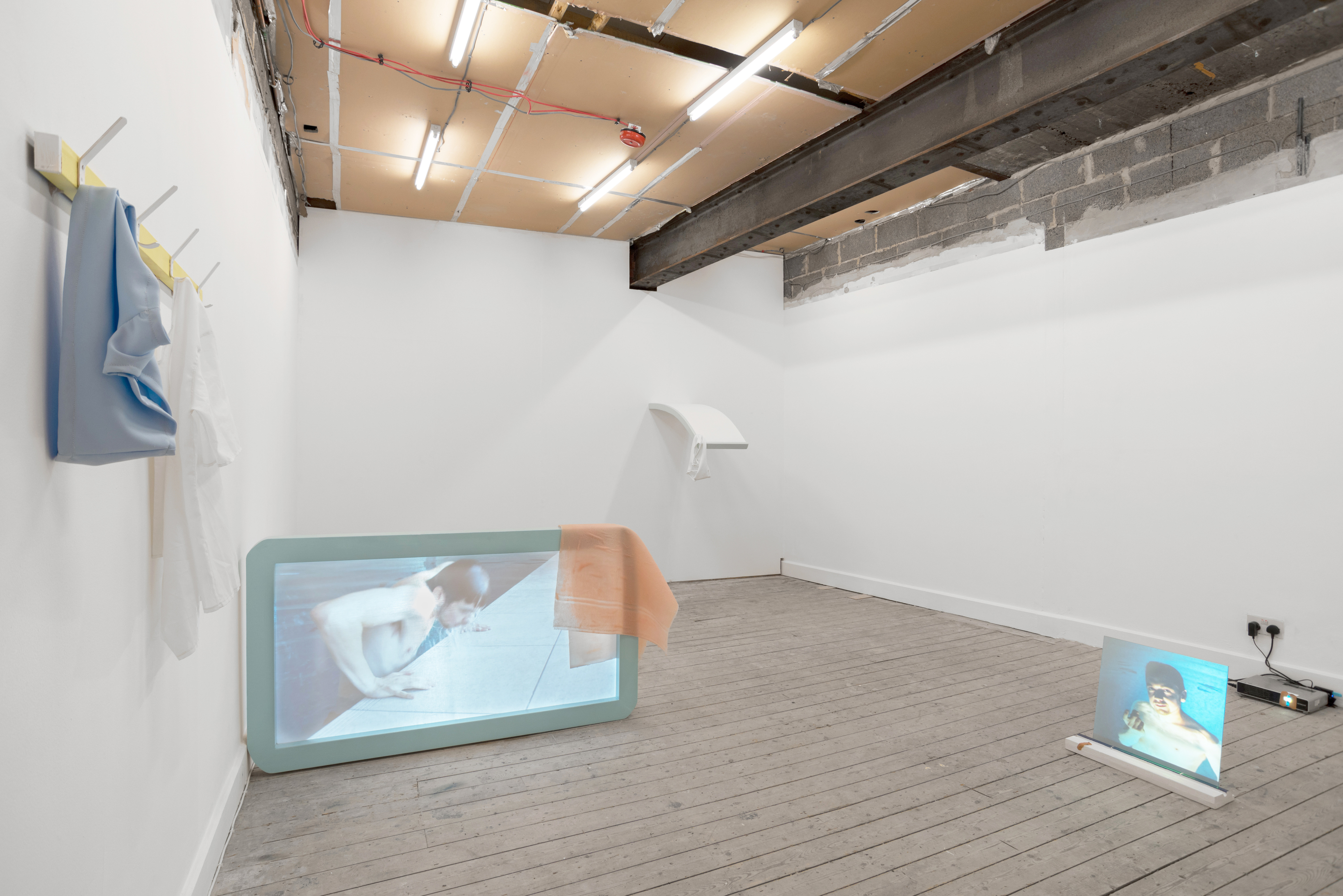Alexander Glass
Interview by David McLeavy
Published August 2017
-

and then the towel fell to the floor, 2015
Elements of your research focus on areas or situations that are commonly associated with masculinity or the macho, I was wondering if you could talk a little more about this and how this has been a starting point to make sculpture?
Masculinity and its complicated relationship with desire is a major concern within my research and sculpture, so I attempt to re-present situations and spaces which are commonly associated with masculine power. It’s this established relationship of male potency in spaces like locker-rooms and gyms that provide perfect starting points for me. Though the precedent for subverting or queering these spaces is well established through porn or through parody, I attempt, by placing my work within these situations to play with a separation from the reality from their representation, allowing for a narrative space which insinuates through material or subtle physical gestures.

Head in the game, 2016
Some of your work uses assemblages of objects and sculptures, many of which are cast. What is your relationship with the process and materiality of casting and why is it important within your work? I am thinking of the work Slip, Slipping, Slipped, 2017 as an example.
I think the major points of casting for me is creating a world which is removed from actuality whilst still indicating it very closely. Transposing the materiality of a known object gives the ability to offer a new meaning to it whilst also developing a greater understanding of the original. The bronze speedos in Slip, Slipping, Slipped, become a material joke through its weight, but I chose speedos particularly because they are an icon desire. The brand itself being stuck between its narrative of professionalism and its revealing nature either subjecting body sexualisation or teenage humiliation. In previous works some of the most important casts have been experiments in order to see what is possible. I think one of my most successful casts are my silicon towels, (towels which are a frequent and symbolic image for me) by having an impermeable rubber quality the image of the towel becomes both satisfying and creepy. That balance is what I’m looking for through all the objects I cast and casting itself is an important marker for my development as a maker because its so often a process of trial and error.
Do you think of your work as a constant experimental process? Also I am interested to know more about your recent experience at the Royal College of Art and whether being involved in postgraduate study has allowed you to experiment more than you perhaps would have prior to enrolling?
The way I work has changed a lot whilst being at the RCA, I’ve developed a studio practice which feels a lot more ambitious than where I was two years ago. I had a habit of having entirely certain images in my mind of how work should look what it should be made out of and how it should be arranged, before it was even made. A certainty that I think restricted the creativity and the narrative potential of my sculpture. In the past year I have embraced an experimental way of working something I wouldn’t have been able to say a little while ago. At the beginning of this year I purposely went through a period of only focusing on objects I loved or had a kind of desire for, in order to allow for a reversal in my relationship between concept and creation. These objects included football socks, katanas and shaving razors and I built up a roster of cast objects that are both symbolic and important to me. These cast then contributed heavily to the construction of my degree show piece Higher Windows. The RCA unlike my previous education at Brighton seemed to have an ethos of everything is a work in progress and there was no pressure to ever show a finished work until the final show. I think that’s been one of the best things for me, to allow myself to constantly assess the important things from previous works were rather than just check off an idea and say ‘I guess that’s done now’. I’ve come out of the experience with a much greater understanding of how I want to articulate myself, a large part of that being down to experimentation but also the discovery of how important academic research is to how I make sculpture.

Higher Windows, RCA Degree Show, London, 2017
Do you feel that your work reflects your personality in some way or do you think of you art practice as something that is detached from you?
My own desire is the foundation of the majority of my work and as a result there is a large part of me in it. Especially went it comes to my confused and often hypocritical attraction to tropes of masculinity. However I see the final outcome as a large exaggeration of my own personality, the sort of person I could be without self-awareness, criticality and sometimes morality. I have narcissistic and gluttonous tendencies but in work I try to explore extremes of those traits. Higher Windows, in which I attempted to build a sense of a character through an insinuated space of a high rise luxury flat and a collection of objects in it. The objects themselves I find beautiful, but together they begin to suggest a coldness and a potential of violence. A peeled torso, a sweaty hand print on the window and a champagne glass filled with a milky substance. A surface world, which has been majorly inspired by the writing of Bret Easton Ellis, particularly the excess and apathy that he is so excellent at portraying. In all the installations I have made in the past year or so I see this conceited male character walking through; the locker room in Head in The Game, the swimming pool in Standing on The Deep End to Higher Windows. He operates an Invisible narrative tool for me to build around. For the character the objective is to project a perfect image of themselves, their body, power and life. My objective in the installations to expose the potential for perversity in those things through subtleties, despite my own desire for the beautiful surface. I acknowledge my personality in the character but as a sort of cautionary tale.

Standing on the Deep End, STCFTHOTS, Leeds, 2016
-
Alexander Glass lives and works in London. He is a recent graduate of The Royal College of Art Sculpture course. His Recent exhibitions include; In Visible Lines, Market Place, Bolton 2017, Creek Side Open, A.P.T Gallery, London 2017 and solo show Standing on The Deep End, STCFTHS Leeds 2016. Alexander has recently been selected in ID magazine as one of ‘5 queer artists you need to know’ and was selected as the winner of the Annex Collection’s Acquisition Award 2017
-
If you like this why not read our interview with Losers Gym ✗
-
© 2013 - 2018 YAC | Young Artists in Conversation ALL RIGHTS RESERVED
